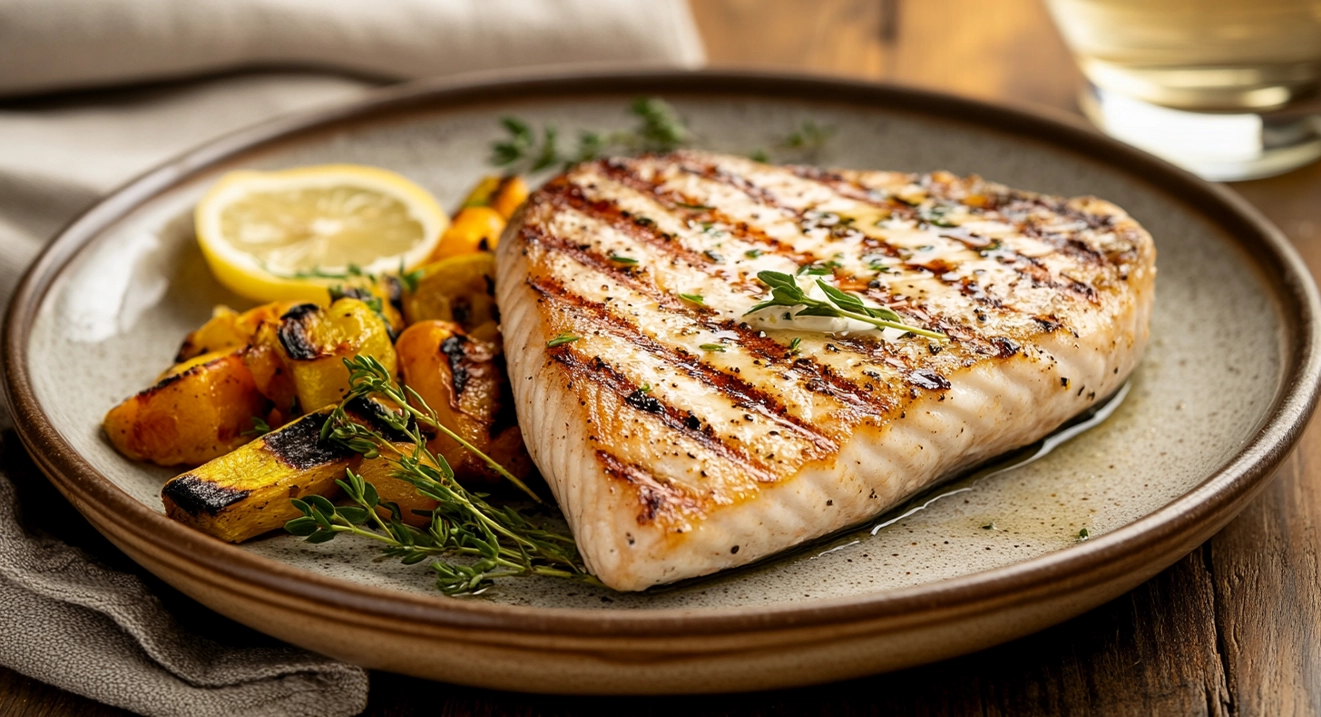Discover the Delicious World of Swordfish: Recipes, Benefits, and Cooking Tips

Introduction to Swordfish Recipe
What is Swordfish?
Swordfish recipe is a large, predatory fish known for its elongated, sword-like bill. It is found in temperate and tropical oceans around the world and is prized for its firm, meaty texture and mild flavor. Unlike flaky white fish, swordfish holds its shape well during cooking, making it a versatile option for various dishes such as grilling, baking, or pan-searing.
Why Choose Swordfish Recipe for Your Meals?
Swordfish is an excellent choice for those who enjoy hearty and satisfying seafood. Its steak-like consistency and subtle flavor make it an ideal canvas for bold marinades, seasonings, and sauces. Whether you’re preparing an elegant dinner or a quick weekday meal, swordfish’s ease of preparation and ability to pair with various sides make it a favorite among seafood lovers.
Nutritional Benefits of Swordfish
Swordfish is not only delicious but also packed with nutrients. It is a rich source of:
- Protein: Promotes muscle growth and repair.
- Omega-3 Fatty Acids: Supports heart health and reduces inflammation.
- Vitamin D: Enhances calcium absorption and strengthens bones.
- Selenium: An antioxidant that helps protect the body from damage caused by free radicals.
Selecting the Right Swordfish
Fresh vs. Frozen: How to Choose
When choosing swordfish, both fresh and frozen options can be excellent, depending on your needs:
- Fresh Swordfish: Opt for fresh swordfish if you plan to cook it within a day or two. Fresh swordfish typically offers the best flavor and texture but requires careful inspection to ensure quality.
- Frozen Swordfish: Frozen swordfish is a convenient option, especially for those who don’t have access to fresh seafood. Modern freezing methods retain much of the fish’s taste and texture, making it a practical choice for more extended storage.
Signs of Freshness in Swordfish
If you’re buying fresh swordfish, look for the following signs to ensure you’re getting a high-quality product:
- Appearance: The flesh should be moist, firm, and free from discoloration. A pinkish or creamy-white hue is ideal.
- Smell: Fresh swordfish should have a clean, ocean-like aroma. Avoid any fish with a strong, sour, or ammonia-like odor.
- Bloodline: Look for a bright red bloodline in the flesh. A brown or dull color can indicate age or poor quality.
- Skin and Surface: If the Skin is attached, it should appear smooth and shiny without any slimy residue.
Sustainability Concerns: Ethical Sourcing
Swordfish populations in some regions have been overfished, raising concerns about sustainability. When purchasing swordfish, consider the following to support ethical sourcing:
- Check Certifications: Look for labels such as the Marine Stewardship Council (MSC) certification, which indicates that the fish was sourced sustainably.
- Know the Origin: Swordfish caught using harpoons or longlines from well-managed fisheries are generally more sustainable than those in high-bycatch areas.
- Avoid Juvenile Fish: Choose swordfish steaks from mature fish to support the population’s reproduction ability.
Preparing Swordfish: Essential Tips

Cleaning and Cutting Swordfish
Handling swordfish properly is crucial for ensuring your dish’s best texture and flavor. Here’s how to clean and cut it:
- Rinse and Pat Dry: If the swordfish has Skin, rinse it under cold water to remove debris or scales. Pat it dry with a paper towel.
- Remove Skin (if desired): While Skin is edible, many prefer to remove it before cooking for a cleaner presentation. Use a sharp knife to separate the Skin from the Skin carefully.
- Trim Dark Flesh: Swordfish steaks often have a strip of darker flesh, which can taste stronger. Trim this away for a milder flavor.
- Cut Evenly: For even cooking, slice the swordfish into steaks or portions of consistent thickness, typically about 1 to 1.5 inches.
Proper Storage Techniques
To maintain the quality and freshness of swordfish, follow these storage guidelines:
- Refrigeration: Store fresh swordfish in the coldest part of your refrigerator and use it within 1-2 days of purchase. Wrap it tightly in plastic wrap or place it in an airtight container to prevent exposure to air.
- Freezing: If you’re not using the fish immediately, freeze it. To prevent freezer burn, wrap the swordfish in plastic wrap and aluminum foil or place it in a vacuum-sealed bag. It can be stored in the freezer for up to three months.
- Defrosting: Thaw frozen swordfish in the refrigerator overnight or use the cold water method by placing it in a sealed bag and submerging it in cold water.
Marination Tips for Enhanced Flavor
Marinating swordfish is an excellent way to enhance its mild flavor while keeping it moist and tender during cooking. Here are some tips for marination:
- Duration: Marinate swordfish for 15-30 minutes. Over-marinating can overpower its flavor or affect its texture.
- Ingredients:
- Acidic Elements: Lemon juice, lime juice, or vinegar add a bright flavor but should be balanced with oil to prevent the fish from “cooking.”
- Oils: Olive or sesame oil helps coat the fish and prevents it from drying.
- Seasonings: Garlic, herbs (like thyme or rosemary), chili flakes, and soy sauce are popular for enhancing swordfish.
- Avoid Excessive Salt: If salty ingredients like soy sauce are used, limit additional salt to avoid oversalting.
Classic Swordfish Recipes
Grilled Swordfish Recipe with Lemon Butter Sauce

Ingredients:
- Four swordfish steaks (1-inch thick)
- 2 tbsp olive oil
- Salt and black pepper, to taste
- Two cloves garlic, minced
- Juice and zest of 1 lemon
- 3 tbsp unsalted butter
- 1 tbsp fresh parsley, chopped (optional garnish)
Instructions:
- Prepare the Fish: Brush the swordfish steaks with olive oil and season both sides with salt and black pepper.
- Preheat the Grill: Heat the grill to medium-high and oil the grates to prevent sticking.
- Grill the Swordfish: Place the steaks on the grill and cook for 3-4 minutes per side until they are opaque and slightly charred. Avoid overcooking to keep the fish moist.
- Make the Sauce: Melt the butter in a small skillet over medium heat. Add the garlic and sauté for 1-2 minutes until fragrant. Stir in the lemon juice and zest, and remove from heat.
- Serve: Drizzle the lemon butter sauce over the grilled swordfish and garnish with parsley, if desired. Serve immediately with a side of grilled vegetables or rice.
Pan-Seared Swordfish Recipe with Herbs

Ingredients:
- Four swordfish steaks (1-inch thick)
- 2 tbsp olive oil
- 2 tbsp unsalted butter
- Two cloves garlic, minced
- 1 tsp fresh thyme leaves
- 1 tsp fresh rosemary, chopped
- Salt and black pepper, to taste
- Lemon wedges for serving
Instructions:
- Season the Fish: Pat the swordfish dry with paper towels—season both sides with salt and black pepper.
- Heat the Pan: In a large skillet, heat olive oil over medium-high heat until shimmering.
- Sear the Swordfish: Add the swordfish steaks to the pan and cook on one side for 3-4 minutes until golden brown. Flip and cook for 3-4 minutes until the fish is opaque and cooked through. Remove the fish from the pan and set aside.
- Make the Herb Butter: Reduce the heat to medium. Add the butter, garlic, thyme, and rosemary to the same pan. Cook for 1-2 minutes, stirring frequently, until the garlic is fragrant and the butter is infused with the herbs.
- Serve: Spoon the herb butter over the swordfish steaks. Serve hot with lemon wedges on the side and a fresh salad or roasted potatoes.
Modern Takes on Swordfish Recipes
Swordfish Recipe Tacos with Mango Salsa
Ingredients:
- 1 lb swordfish, cut into small chunks
- 1 tbsp olive oil
- 1 tsp chili powder
- 1/2 tsp cumin
- 1/2 tsp smoked paprika
- Salt and black pepper, to taste
- Eight small flour or corn tortillas
- 1 cup shredded cabbage or lettuce
- 1/2 cup sour cream or yogurt (optional)
For Mango Salsa:
- One ripe mango, diced
- 1/4 red onion, finely chopped
- One small jalapeño, seeded and minced
- Juice of 1 lime
- 2 tbsp fresh cilantro, chopped
- Salt, to taste
Instructions:
- Prepare the Fish: Toss swordfish chunks with olive oil, chili powder, cumin, smoked paprika, salt, and pepper.
- Cook the Fish: Heat a skillet over medium-high heat. Sear the swordfish for 3-4 minutes until cooked through. Remove from heat.
- Make Mango Salsa: Combine mango, red onion, jalapeño, lime juice, cilantro, and a pinch of salt in a bowl. Mix well and set aside.
- Assemble the Tacos: Warm the tortillas, then layer with cabbage, cooked swordfish, and mango salsa. Top with a dollop of sour cream or yogurt, if desired. Serve immediately.
Swordfish Poke Bowls
Ingredients:
- 1 lb swordfish, cut into small cubes
- 1/4 cup soy sauce
- 1 tbsp sesame oil
- 1 tbsp rice vinegar
- 1 tsp honey
- 1 tsp grated ginger
- 1/2 tsp crushed red pepper flakes
- 2 cups cooked sushi rice
- 1 cup diced cucumbers
- 1 cup diced avocado
- 1/4 cup sliced green onions
- 1 tbsp sesame seeds
Instructions:
- Marinate the Swordfish: In a bowl, mix soy sauce, sesame oil, rice vinegar, honey, grated ginger, and red pepper flakes. Add the swordfish cubes and toss to coat. Let it marinate for 15-20 minutes in the refrigerator.
- Assemble the Bowls: Divide the sushi rice among four bowls. Top with marinated swordfish, cucumbers, avocado, and green onions.
- Garnish: Sprinkle sesame seeds over the bowl. Serve chilled or at room temperature.
Swordfish Skewers with Mediterranean Flavors
Ingredients:
- 1 lb swordfish, cut into 1-inch cubes
- 2 tbsp olive oil
- 2 tbsp lemon juice
- 1 tsp dried oregano
- 1/2 tsp garlic powder
- 1/2 tsp smoked paprika
- Salt and black pepper, to taste
- One red bell pepper, cut into chunks
- One red onion, cut into chunks
- One zucchini, sliced into rounds
- Wooden skewers (soaked in water for 30 minutes)
Instructions:
- Prepare the Marinade: In a bowl, mix olive oil, lemon juice, oregano, garlic powder, smoked paprika, salt, and pepper.
- Marinate the Swordfish: Toss the swordfish cubes in the marinade and let sit for 20-30 minutes.
- Assemble the Skewers: Thread swordfish, bell pepper, onion, and zucchini onto the skewers, alternating ingredients.
- Grill the Skewers: Preheat a grill or grill pan to medium-high heat. Cook the skewers for 3-4 minutes per side until the fish is cooked and the vegetables are slightly charred.
- Serve: Pair with a side of tzatziki sauce or a fresh Greek salad for a complete Mediterranean meal.
Frequently Asked Questions about Swordfish Recipe
What is the Best Method of Cooking Swordfish?
Swordfish is a versatile fish that lends itself well to various cooking methods. The most popular techniques include:
- Grilling is ideal for bringing out the natural flavors and achieving a slightly smoky taste. Swordfish steaks hold well on the grill and develop a deliciously charred exterior.
- Pan-Searing: Quick and easy, this method creates a golden crust while keeping the inside moist and tender.
- Baking: A healthy, low-maintenance option that works well when paired with marinades or sauces.
- Broiling: Similar to grilling but done in the oven, broiling adds a nice caramelized finish to swordfish steaks.
What Pairs Well with Swordfish?
Swordfish’s mild flavor and firm texture make it a versatile companion for many sides and accompaniments. Some great pairings include:
- Vegetables: Grilled asparagus, roasted Brussels sprouts, or a fresh salad.
- Starches: Rice pilaf, mashed potatoes, or couscous complement swordfish beautifully.
- Citrus Sauces: Lemon butter, lime vinaigrette, or orange glaze brighten the fish’s flavor.
- Mediterranean Flavors: Ingredients like olives, capers, tomatoes, and fresh herbs (parsley, dill, or basil) enhance swordfish dishes.
Is Swordfish a Good Fish to Eat?
Yes, swordfish is a delicious and nutritious choice. It is:
- Rich in Protein: Supports muscle growth and repair.
- High in Omega-3 Fatty Acids: Promotes heart health and reduces inflammation.
- A Good Source of Vitamin D and Selenium: Supports bone health and provides antioxidant benefits.
However, swordfish should be eaten moderately due to its potential mercury content, especially for pregnant women and young children.
How Should Swordfish Recipe Be Served?
Swordfish can be served in many ways depending on the occasion and recipe. Popular serving styles include:
- As Steaks: A classic presentation with sides like vegetables and starches.
- In Tacos: With fresh toppings like mango salsa or slaw for a casual meal.
- In Skewers: Paired with grilled vegetables for a Mediterranean-inspired dish.
- In Bowls: Served with rice, fresh veggies, and sauces for a modern, balanced meal.
Health Benefits and Risks of Eating Swordfish

Omega-3 Fatty Acids and Their Benefits
Swordfish is a rich source of omega-3 fatty acids, which offer numerous health benefits, including:
- Heart Health: Omega-3s help reduce triglycerides, lower blood pressure, and decrease the risk of heart disease.
- Brain Function: They support cognitive function and may reduce the risk of neurodegenerative diseases like Alzheimer’s.
- Anti-Inflammatory Effects: Omega-3s help combat inflammation, which can improve conditions such as arthritis.
- Eye Health: They contribute to retinal health and can reduce the risk of age-related macular degeneration.
Including swordfish in your diet occasionally is a delicious way to increase your intake of these essential fats.
Mercury Content in Swordfish Recipe : Should You Worry?
While swordfish is nutritionally dense, it does have a downside: its mercury content. Larger fish, like swordfish, tend to accumulate higher levels of mercury due to their position in the food chain.
- Who Should Limit Intake? Pregnant women, breastfeeding mothers, young children, and individuals with mercury sensitivity should minimize or avoid swordfish consumption.
- How Much is Safe? Consuming swordfish occasionally (e.g., once a month) is unlikely to harm the general population. Opting for smaller portions and diversifying your seafood choices can mitigate risks.
If you’re concerned about mercury, consult guidelines from health authorities like the FDA or EPA for recommended seafood options and portions.
Serving Size Recommendations
To enjoy swordfish safely while reaping its health benefits, adhere to proper portion sizes:
- Adults: A serving of swordfish is typically 4-6 ounces (115-170 grams) of cooked fish.
- Children: For children, servings should be smaller, around 2-3 ounces (50-85 grams), depending on age and dietary needs.
Conclusion: Why Swordfish Reciep Should Be on Your Plate
Recap of Benefits
Swordfish is a versatile, flavorful, and nutrient-rich seafood that deserves a place in your meal rotation. With its high protein content, heart-healthy omega-3 fatty acids, and essential vitamins like vitamin D and selenium, swordfish supports overall health while satisfying your taste buds. Whether you grill, sear, bake, or skewer it, swordfish delivers a hearty and satisfying dining experience.
Encouragement to Try New Recipes
From classic preparations like grilled swordfish with lemon butter sauce to modern takes like swordfish tacos and poke bowls, there are countless ways to enjoy this delicious fish. Experiment with different marinades, seasonings, and accompaniments to discover your favorite combinations and make swordfish a standout on your menu.
Invitation to Share Your Creations
We’d love to hear from you! Have you tried any swordfish recipes that you loved? Or have you created your unique take on this incredible seafood? Share your culinary creations, tips, and experiences with us—we’re excited to see how swordfish inspires you in the kitchen!
